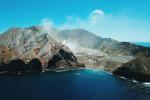Click here to go on a virtual tour of White Island (Whakaari) made last year using Google Street View.
White Island (Whakaari) is an active volcano, situated 48 km from the coastal town, Whakatane. The island is the largest of the four islands in the Olive island chain. It is roughly circular, about two km in diameter, and rises to a height of 321 m above sea level.
However this is only the peak of a much larger submarine mountain, which rises up to 1600 m above the nearby sea floor.
The main activities on the island now are guided tours and scientific research.
White island attracts visitors from all over the world including a variety of sea life.
White Island is also one of world’s best scuba diving destinations and provides a unique dive experience as you can explore the underwater steam vents or commune with large schools of fish. It attracts hundreds of divers from all over the world every year.
White island has been accessible by boat or helicopter or you can opt for a scenic flight over the island.
History of the Island
Mining was attempted in the mid-1880s, again from 1898 to 1901, and then from 1913 to 1914, to mine sulphur.
Mining came to a halt in September 1914, when part of the western crater rim collapsed, creating a lahar that killed all 10 workers, who disappeared without trace. Only a camp cat survived, found some days afterwards by the resupply ship and dubbed "Peter the Great".
Again in 1923, mining was again tried, the miners built their huts on a flat part of the island near a gannet colony.
Before the days of antibiotics, sulphur was used as an antibacterial agent in medicines, in the making of match-heads, and for sterilising wine corks.
The sulphur was hauled to the crushing plant in small rail trucks, and a bagging facility was also constructed. However, there was not enough sulphur in the material mined at the island, so the ground-up rock was used as a component of agricultural fertiliser.
Mining ended in the 1930s, because of the inadequate mineral content in the fertiliser.
The remains of the buildings involved can still be seen, heavily corroded by the sulphuric gases.
Whakaari erupted continually from December 1975 until September 2000, marking the world's longest historic eruption episode, according to GeoNet, and also in 2012, 2016.
Sources https://www.whakatane.info, Wikipedia, NZ History



